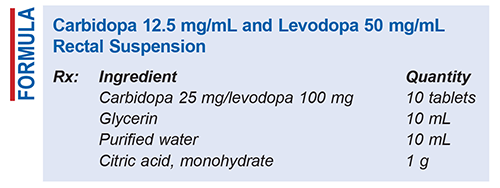US Pharm. 2024;49(1):59-60.

Method of Preparation: Calculate the amount of each ingredient required for the total amount to be prepared. Remove trademark imprint from tablets with a paper towel dampened with Alcohol USP; let tablets air-dry for a few minutes. Use a mortar and pestle to crush and triturate tablets into a fine powder.
Dissolve the citric acid in water. Using a stir rod, mix glycerin thoroughly with the citrated water. Add sufficient glycerin-citrate mixture to the powder to form a smooth, homogenous paste. Gradually add half of the remaining glycerin-citrate mixture, mixing thoroughly. Transfer the resulting suspension to a graduated cylinder. Adjust volume to desired level by adding the remaining glycerin-citrate mixture; mix well with a stir rod. Transfer the resulting liquid to an amber polypropylene bottle, and shake it vigorously to achieve a uniform suspension.
Use: Carbidopa/levodopa rectal suspension may be used to treat Parkinson’s disease (PD).1 This delivery form may be useful for PD patients who have difficulty taking oral medications.
Packaging: Package in a tight, light-resistant, amber polypropylene bottle.
Labeling: Keep out of reach of children. Shake well. Discard after ____ [time period].
Stability: The suspension remains stable for 10 days at a controlled room temperature of 22°C. If the suspension is stored at a refrigerated temperature of 5°C, stability is maintained for 35 days.1
Quality Control: Weight/volume, pH, specific gravity, active drug assay, color, rheologic properties/pourability, physical observation, and physical stability (discoloration, foreign materials, gas formation, mold growth) are all examples of quality-control assessments.2
Discussion: The carbidopa/levodopa combination (Sinemet), which is utilized in the management of PD, is available in three strengths (carbidopa/levodopa 25 mg/100 mg, 10 mg/100 mg, and 25 mg/250 mg), and its inactive ingredients include cellulose, magnesium stearate, and starch.1,3 Carbidopa (C10H14N2O4 • H2O, MW 244.3), a dopa decarboxylase inhibitor, is a white, crystalline compound that inhibits conversion of the dopamine precursor levodopa to dopamine, reducing peripheral adverse effects. Levodopa (C9H11NO4, MW 197.2), an aromatic amino acid, is an odorless, tasteless, crystalline compound with slight water solubility. Levodopa acts by crossing the blood-brain barrier and alleviating PD’s characteristic signs of resting tremor, rigidity, and bradykinetic movements. Carbidopa enhances levodopa’s efficacy by reducing the required dose and increasing its plasma levels and half-life while decreasing plasma and urinary dopamine and homovanillic acid. When these drugs are coadministered, carbidopa extends levodopa’s half-life of approximately 50 minutes to about 1.5 hours. Importantly, levodopa must be discontinued at least 12 hours before carbidopa/levodopa therapy is initiated.3
Glycerin (C3H8O3, MW 92.09) is a clear, odorless liquid with a sweet taste that is 0.6 times sweeter than sucrose. It is 95% soluble in water, ethanol, and methanol and slightly soluble in oils, benzene, and chloroform. Glycerin should be stored in an airtight container in a cool, dry environment; it is hygroscopic and may crystallize if stored at low temperatures. Glycerin is used as an antimicrobial preservative, emollient, humectant, plasticizer, solvent, and sweetening/tonicity agent. Glycerin acts as a humectant and emollient in topical formulations, keeping surfaces moist by drawing in moisture. It is used as a preservative and as a sweetening agent in oral solutions.4
Citric acid (citric acid monohydrate, C6H8O7 • H2O) is available as colorless or translucent crystals and as a white, crystalline, efflorescent powder. It is odorless and has a strong, tart, acidic taste. The hydrated form may effloresce and the anhydrous form is hygroscopic, depending on the presence of humidity. In very dry air, it may lose water content at around 40°C. Citric acid’s melting point is about 100°C, and it softens at around 75°C. In solubility tests, 1 g dissolves in less than 1 mL of water and 1.5 mL of ethanol. Citric acid is commonly used as a stabilizer and pH adjuster.5
Purified water is water that has been filtered via distillation, ion exchange, reverse osmosis, or another suitable process. It is miscible with most polar solvents and is chemically stable in all physical states.6
REFERENCES
1. Donnelly RF. Stability of levodopa/carbidopa rectal suspensions. Hosp Pharm. 2016;51(11):915-921.
2. Allen LV Jr. Standard operating procedure for performing physical quality assessment of oral and topical liquids. IJPC. 1999;3:146-147.
3. Sinemet (carbidopa and levodopa) product information. Whitehouse Station, NJ: Merck & Co, Inc; March 2020.
4. Glycerin. In: Rowe RC, Sheskey PJ, Owen SC, eds. Handbook of Pharmaceutical Excipients. 5th ed. Washington, DC: American Pharmaceutical Association; 2006:301-303.
5. Amidon GE. Citric acid monohydrate. In: Rowe RC, Sheskey PJ, Cook WG, Fenton ME, eds. Handbook of Pharmaceutical Excipients. 7th ed. Washington, DC: American Pharmaceutical Association; 2012:193-196.
6. Dubash D, Shah U. Water. In: Sheskey PJ, Cook WG, Cable CG, eds. Handbook of Pharmaceutical Excipients. 8th ed. Washington, DC: American Pharmaceutical Association; 2017:1012-1016.
The content contained in this article is for informational purposes only. The content is not intended to be a substitute for professional advice. Reliance on any information provided in this article is solely at your own risk.
To comment on this article, contact rdavidson@uspharmacist.com.





